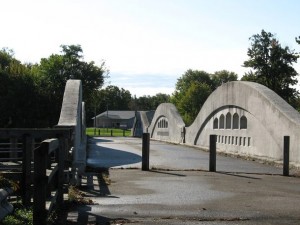 Construction
Construction
Constructed in 1922, this three-span 270-foot-long bridge is the longest Michigan example of a reinforced concrete camelback bridge. These bridges are found primarily in Michigan and Ontario, Canada, and the Mottville Bridge is an excellent example of this design. It was built by contractors Smith and Nichols of Hastings under the direction of State Bridge Engineer C.A. Melick. The Michigan State Highway Department pioneered the use of standardized designs for concrete bridges. By the early 1920’s the department had established standardized plans for camelback spans of 50, 60, 70, 75 and 90 feet. This bridge contains three identical 90 foot spans. It was preserved as an engineering landmark by the Michigan Department of Transportation when the present U.S. 12 bridge was erected.
History of the Bridge
The Great Sauk Trail, which connected Detroit, Chicago and Green Bay, Wisconsin crossed the St. Joseph River at a shallow spot in this vicinity. Responding to the westward migration of the pioneers the federal government surveyed the trail and converted it into the Chicago Road Bridge (presently U.S. 12) in 1825. The first Chicago Road bridge to cross the river near Mottville was a substantial timber structure constructed in 1833-34 by contractor Hart L. Stewart. A pile-supported bridge replaced it in 1845. In 1867 Mahlon Thompson and Joseph Miller built a covered Burr arch truss. The ruins of its stone-block abutments are visible upstream from the current Mottville Bridge. This three-span camelback bridge was built in 1922. In 1990, U.S. 12 was rerouted over a new bridge. The camelback bridge is now used for foot traffic.
Bureau of History, Michigan Department of State Registered State Site No. 576